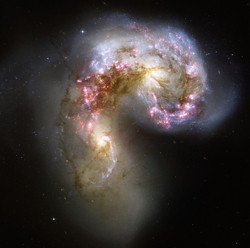Stardust, star burst and galaxies
Models predict that galaxies are formed during hierarchical mergers in a gradual assembly of neighbouring galaxies. The interaction of gas and dust creates starburst activity. However, massive early-type elliptical galaxies lack large quantities of cool dust and gas and are defined by their old stellar populations. EU-funded scientists validated a proposed solution to this long-standing problem with seminal work on the project ‘Galaxy evolution: solving the hierarchy problem with powerful AGN’ (THE HIERARCHY PROBE). They exploited access to the very latest space observations from the EU’s Herschel Space Observatory together with elegant analytical techniques. Active galactic nuclei (AGN) are super-massive black holes at the centre or nuclei of galaxies which emit brief but very high-energy jets of elementary particles. They were considered the most likely candidates to inhibit star formation but a direct link between AGN and star formation was missing. Dust has been the best indicator of star formation because it absorbs the radiation from hot young stars and re-emits it at infrared wavelengths. However, AGN can also heat the dust. With priority and an exceptional 29 hours of the Herschel Director's Discretionary 'Must Do' photometry at wavelengths covering dust of many different types and temperatures, the team provided compelling evidence linking AGN with lack of star formation. For the first time, data has enabled a generalisation of the overall population of galaxies. Scientist showed that galaxies with AGNs whose jet activity dominates their emission spectra have relatively large amounts of dust compared to those without yet star formation is suppressed. Approximately 15 % has even more dust than intensely star-forming galaxies. Physical dust models based on the spectra will provide robust and fully empirical spectral energy distribution templates of AGN for the first time. Researchers have provided compelling evidence linking AGN with heavy jet activity to the suppression of star formation. Continued work is certain to benefit many other teams that can build on the foundations laid by THE HIERARCHY PROBE.







